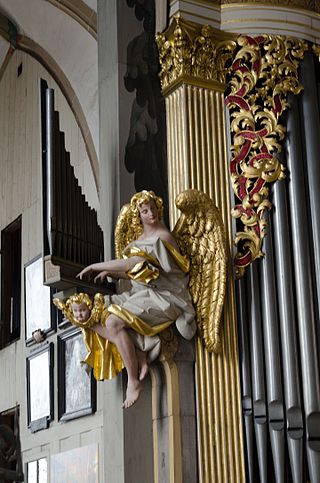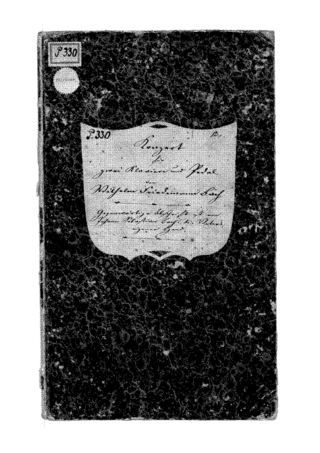The Bach-Werke-Verzeichnis is a catalogue of compositions by Johann Sebastian Bach. It was first published in 1950, edited by Wolfgang Schmieder. The catalogue's second edition appeared in 1990. An abbreviated version of that second edition, known as BWV2a, was published in 1998.

The Toccata and Fugue in D minor, BWV 565, is a piece of organ music written, according to its oldest extant sources, by Johann Sebastian Bach (1685–1750). The piece opens with a toccata section, followed by a fugue that ends in a coda. Scholars differ as to when it was composed. It could have been as early as c. 1704. Alternatively, a date as late as the 1750s has been suggested. To a large extent, the piece conforms to the characteristics deemed typical of the north German organ school of the Baroque era with divergent stylistic influences, such as south German characteristics.

Sechs Chorale von verschiedener Art: auf einer Orgel mit 2 Clavieren und Pedal vorzuspielen, commonly known as the Schübler Chorales, BWV 645–650, is a set of chorale preludes composed by Johann Sebastian Bach. Johann Georg Schübler, after whom the collection came to be named, published it in 1747 or before August 1748, in Zella St. Blasii. At least five preludes of the compilation are transcribed from movements in Bach's church cantatas, mostly chorale cantatas he had composed around two decades earlier.

Toccata, Adagio, and Fugue in C major is an organ composition by Johann Sebastian Bach. As is the case with most other organ works by Bach, the autograph score does not survive. The earliest manuscript copies were probably made in 1719–1727. The title of the piece in these copies is given, as expected of organ literature of the time, simply as Toccata in C major. The piece is an early work, probably composed in the mid-to-late Weimar years, i.e. 1710–1717. It shares some similarities with other toccatas composed around the same time, such as BWV 538, BWV 540, and others: all show the influence of concerto style and form.

Johann Sebastian Bach was a German composer and musician of the late Baroque period. He is known for his orchestral music such as the Brandenburg Concertos; instrumental compositions such as the Cello Suites; keyboard works such as the Goldberg Variations and The Well-Tempered Clavier; organ works such as the Schubler Chorales and the Toccata and Fugue in D minor; and vocal music such as the St Matthew Passion and the Mass in B minor. Since the 19th-century Bach revival he has been generally regarded as one of the greatest composers in the history of Western music.

Prelude and Fugue in A minor, BWV 543 is a piece of organ music written by Johann Sebastian Bach sometime around his years as court organist to the Duke of Saxe-Weimar (1708–1713).

The keyboard concertos, BWV 1052–1065, are concertos for harpsichord, strings and continuo by Johann Sebastian Bach. There are seven complete concertos for a single harpsichord, three concertos for two harpsichords, two concertos for three harpsichords, and one concerto for four harpsichords. Two other concertos include solo harpsichord parts: the concerto BWV 1044, which has solo parts for harpsichord, violin and flute, and Brandenburg Concerto No. 5 in D major, with the same scoring. In addition, there is a nine-bar concerto fragment for harpsichord which adds an oboe to the strings and continuo.
Johann Peter Kellner was a German organist and composer. He was the father of Johann Christoph Kellner.

The Bach-Busoni Editions are a series of publications by the Italian pianist-composer Ferruccio Busoni (1866–1924) containing primarily piano transcriptions of keyboard music by Johann Sebastian Bach. They also include performance suggestions, practice exercises, musical analysis, an essay on the art of transcribing Bach's organ music for piano, an analysis of the fugue from Beethoven's 'Hammerklavier' sonata, and other related material. The later editions also include free adaptations and original compositions by Busoni which are based on the music of Bach.

The Well-Tempered Clavier, BWV 846–893, consists of two sets of preludes and fugues in all 24 major and minor keys for keyboard by Johann Sebastian Bach. In the composer's time, clavier, meaning keyboard, referred to a variety of instruments, most typically the harpsichord or clavichord, but not excluding the organ.
The Fugue in G minor, BWV 131a, is a piece of organ music attributed to Johann Sebastian Bach. It is a transcription of the last movement of his cantata Aus der Tiefen rufe ich, Herr, zu dir, BWV 131. The cantata is definitely by Bach, while the arrangement for organ is regarded by some authorities as spurious. The organ version likely originated after the cantata, which was composed in 1707.

The Chromatic Fantasia and Fugue in D minor, BWV 903, is a work for harpsichord by Johann Sebastian Bach. Bach probably composed it during his time in Köthen from 1717 to 1723. The piece was already regarded as a unique masterpiece during his lifetime. It is now often played on piano.

Prelude and Fugue in E minor, BWV 548 is a piece of organ music written by Johann Sebastian Bach sometime between 1727 and 1736, during his time in Leipzig. The work is sometimes called "The Wedge" due to the chromatic outward motion of the fugue theme. Unlike most other organ preludes and fugues of Bach, the autograph fair copy of the score survives, though the handwriting changes twenty two measures into the fugue to the hand of Johann Peter Kellner, a likely pupil and acquaintance of Bach who played an important role in the copying of his manuscripts. Because of the work's immense scope, it has been referred to as "a two-movement symphony" for the organ.

The organ sonatas, BWV 525–530 by Johann Sebastian Bach are a collection of six sonatas in trio sonata form. Each of the sonatas has three movements, with three independent parts in the two manuals and obbligato pedal. The collection was put together in Leipzig in the late 1720s and contained reworkings of prior compositions by Bach from earlier cantatas, organ works and chamber music as well as some newly composed movements. The sixth sonata, BWV 530, is the only one for which all three movements were specially composed for the collection. When played on an organ, the second manual part is often played an octave lower on the keyboard with appropriate registration. Commentators have suggested that the collection might partly have been intended for private study to perfect organ technique, some pointing out that its compass allows it to be played on a pedal clavichord. The collection of sonatas is generally regarded as one of Bach's masterpieces for organ. The sonatas are also considered to be amongst his most difficult compositions for the instrument.

The organ concertos of Johann Sebastian Bach are solo works for organ, transcribed and reworked from instrumental concertos originally composed by Antonio Vivaldi and the musically talented Prince Johann Ernst of Saxe-Weimar. While there is no doubt about the authenticity of BWV 592–596, the sixth concerto BWV 597 is now probably considered to be spurious. Composed during Bach's second period at the court in Weimar (1708–1717), the concertos can be dated more precisely to 1713–1714.

Prelude and Fugue in C minor, BWV 546 is a piece of organ music written by Johann Sebastian Bach, with the prelude dating around his time in Leipzig (1723–1750), and the fugue dating around his time in Weimar (1708–1717). Like most other organ prelude and fugues of Bach, no autograph score survives, with the oldest known score copied by Johann Peter Kellner, an acquaintance of Bach. The work was played as a postlude for the funeral of Diana, Princess of Wales, the funeral of Prince Philip, Duke of Edinburgh, and the Committal of Queen Elizabeth II by organists Martin Neary and Luke Bond, respectively.













